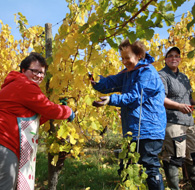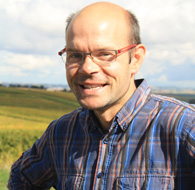The Joseph Scharsch Estate
WINEMAKERS IN WOLXHEIM SINCE 1755
The beginnings of this human adventure date back to 1755, the records from that time mention the marriage of Catherine Schirr to Joseph Scharsch, already mentioned as a winemaker in the street leading to the church. Since then, eight generations of winemakers have successively developed this vineyard.
A new page started in August 2011 when Joseph passed on. He had been a passionate winemaker since 1971; his work left a permanent mark on the estate.
12 HECTARES CULTIVATED ORGANICALLY
The 35 plots that presently make up the estate are spread throughout the five surrounding municipalities, with each piece of land having its own singular terroir and combination of soil and exposure. This diversity of terroir constitutes the greatest wealth, allowing the cultivation of one of the seven Alsace grape varieties (Sylvaner, Pinot Blanc, Pinot Gris, Pinot Noir, Muscat, Riesling and Gewürztraminer) in a location where it thrives fully.
An eighth variety, the Chardonnay, is dedicated exclusively to Crémant (Sparkling Wine).
Since 2009, the whole area has been dedicated to organic production, without herbicides or fertilisers or chemical treatment products.
Diseases are controlled with natural products like Bordeaux mixture, sulphur or plants like nettle or horsetail. The natural fertility of the soil is maintained by composting. Grass growth is controlled by weeding or soil tillage.
Ethical and quality aspects.
Ethical to cultivate a healthy product and hand on "clean" land to our children.
Quality because with organic cultivation, vines produce fewer grapes. Production is naturally controlled. Organic vines also have better roots to draw deep mineral elements naturally available in soil. The wines produced combine purity and minerality.
Wines « REAL »
Wine is made in a spirit of continuity with the growth of the vine to reveal the best of each plot in its wine. Wine is fermented through the natural yeast present in grapes without adding commercial yeasts. They are thus slower, less harsh and favour the complexity of aromas. It is also one of the keys to allowing each vintage to acquire its own identity.
The wines then grow by feeding on their lees until the following spring. This cultivation period allows the wine to "grow" and its various components to combine to then age well over time.





 12, rue de l'Eglise - 67120 Wolxheim Tel : 03 88 38 30 61
12, rue de l'Eglise - 67120 Wolxheim Tel : 03 88 38 30 61